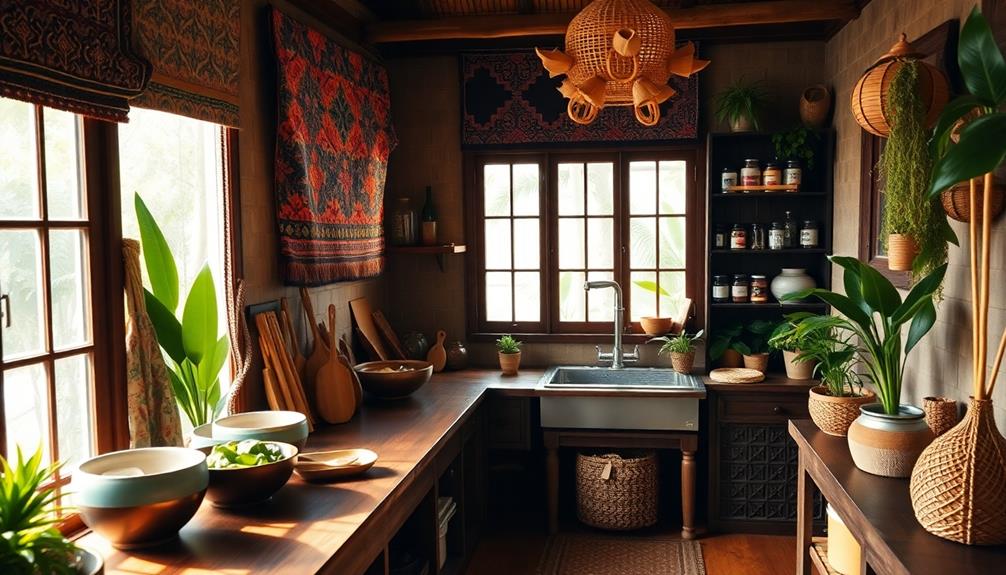Indonesian art decor can transform your home into a vibrant haven. You'll find exquisite pieces that showcase intricate patterns and rich colors, each telling a unique story. Think about incorporating batik fabrics or Sumba ikat textiles to add depth and cultural flair. Versatile rattan furnishings bring a natural elegance, perfect for any space. Plus, intricate wood carvings and Javanese wayang puppets offer a nod to Indonesia's rich heritage. By embracing earthy tones, you create a warm atmosphere that invites tranquility. To discover how these elements can elevate your living space even further, keep exploring the possibilities within Indonesian art decor!
Key Takeaways
- Incorporate vibrant batik textiles as wall art or cushion covers to add a cultural and colorful touch to your home decor.
- Use intricately carved wooden furniture to enhance elegance and showcase Indonesian craftsmanship in your living spaces.
- Embrace sustainable rattan furnishings for a natural aesthetic that is both versatile and eco-friendly, suitable for any interior style.
- Layer traditional ikat fabrics to infuse texture and rich cultural narratives, enhancing the overall ambiance of your rooms.
- Integrate earthy tones with indoor plants to create a warm, inviting atmosphere that promotes harmony and comfort in your home.
Overview of Indonesian Art Decor
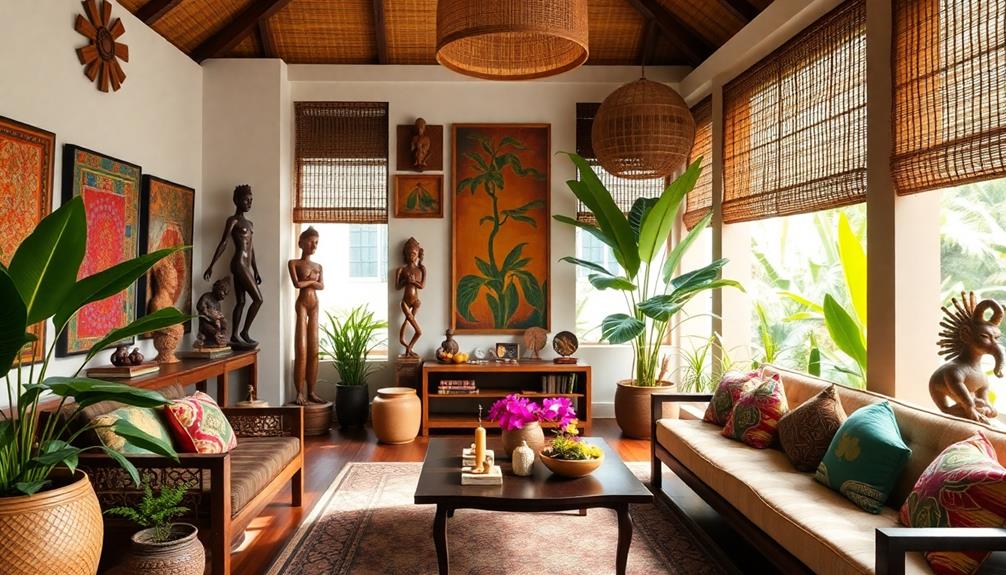
Indonesian art decor's vibrant essence captivates anyone who encounters it. This unique style is marked by its intricate patterns and rich colors, reflecting the diverse cultural influences found throughout the Indonesian archipelago. When you incorporate Indonesian art decor into your home, you embrace a world of tradition and craftsmanship that enhances any space. If you are looking to incorporate Indonesian art decor into your home, there are a few tips to keep in mind. Firstly, consider using traditional Indonesian textiles such as batik or ikat for throw pillows or wall hangings. Secondly, opt for furniture and decor pieces with intricate carvings or designs, such as wooden coffee tables or hand-painted ceramics. These small touches can transport you to the vibrant and culturally rich world of Indonesia right in your own home. Overall, Indonesian decorating tips can help you infuse your space with the vibrant essence of Indonesian art decor.
Remarkably, the use of traditional artistry in the form of decorative masks adds a distinctive touch that showcases local heritage and storytelling.
A standout feature of this decor is the use of wooden furniture, often beautifully carved with elaborate designs that add elegance and artistry. These pieces aren't just functional; they tell a story of the artisans who made them.
The earthy tones found in Indonesian decor create a warm, inviting atmosphere, promoting a sense of harmony and balance.
Natural materials like rattan and bamboo further contribute to this aesthetic, aligning with sustainable practices that celebrate the environment.
You'll find that the design principles of Indonesian art decor emphasize integrating elements of nature, ensuring your living spaces feel cohesive and serene.
The Beauty of Batik
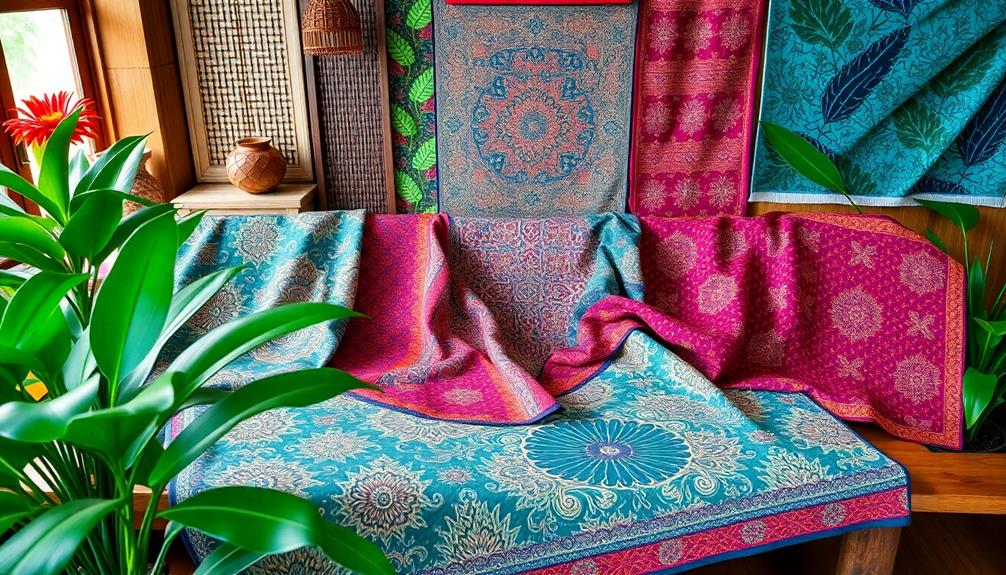
Batik embodies the vibrant spirit of Indonesian art decor, showcasing a stunning blend of tradition and creativity. This traditional fabric art form features intricate patterns and vibrant colors, making it a perfect addition to your home decor.
Recognized by UNESCO, batik represents a rich cultural heritage that you can celebrate through your interior design. The versatility of batik allows it to complement various styles, whether modern or traditional, enhancing the overall aesthetic of your living spaces.
For those looking to explore more about Indonesian art decor, incorporating batik into your home can elevate your space in various ways:
- Wall Art: Create stunning focal points by using batik fabric as wall hangings or framed art.
- Cushion Covers: Add a splash of color and texture to your living room or bedroom with batik cushion covers.
- Table Runners: Enhance your dining experience by using batik table runners that tell a story.
- Fashion Accessories: Use batik to make unique scarves or bags that reflect your artistic flair.
Sumba Ikat Fabric
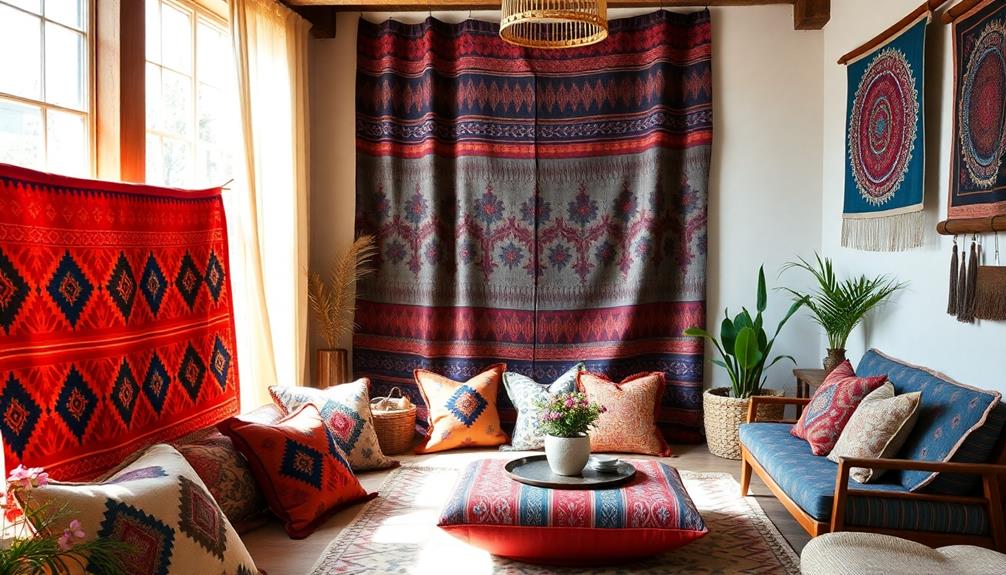
Have you ever marveled at the intricate designs of Sumba Ikat fabric? This unique textile hails from Sumba Island and showcases a rich tapestry of motifs that reflect the region's vibrant cultural heritage.
Made from cotton yarn, each piece is dyed using traditional methods, utilizing natural materials like minerals and plants, such as Kombu Indigo, to create stunning colors that stand the test of time. These textiles, much like the Indonesian decor masks, represent the country's rich artistry and craftsmanship, making them perfect for enhancing your home decor.
What makes Sumba Ikat truly enchanting is the diversity in styles and techniques employed by different regions within Sumba. Each area has its own artistic expressions, making every piece a one-of-a-kind treasure.
As you explore Sumba Ikat, you'll discover how contemporary designers, including the renowned Kelly Wearstler, have embraced its aesthetic appeal and cultural significance, integrating it into modern decor.
These intricate designs aren't just beautiful textiles; they embody a significant art and craft tradition in Indonesian culture.
By incorporating Sumba Ikat fabric into your home, you're not only adding a creative touch but also celebrating a rich heritage that tells a story of artistry and tradition.
Don't miss the chance to bring this cultural gem into your living space!
Versatile Rattan Furnishings
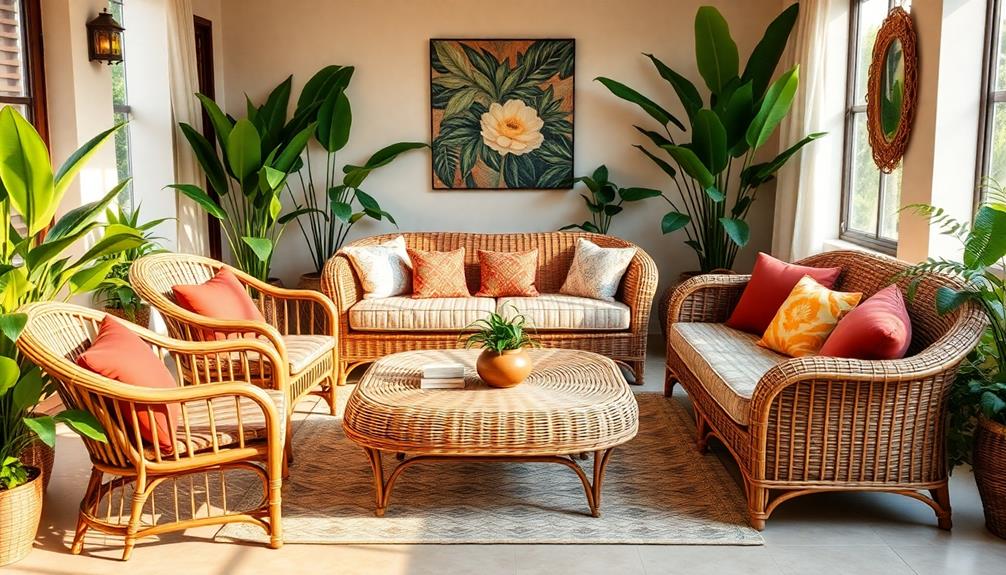
When you choose rattan furnishings, you're not just opting for style; you're embracing a natural aesthetic that enhances any space.
Its durability and versatility make it perfect for both indoor and outdoor settings, allowing you to create a cohesive look throughout your home.
Incorporating rattan pieces can beautifully complement the Balinese design characteristics, promoting a connection to nature and enhancing the overall ambiance.
Plus, as a sustainable material, rattan supports eco-friendly design without sacrificing elegance.
Rattan's Natural Aesthetic Appeal
Rattan's natural aesthetic appeal lies in its remarkable versatility, making it a favorite choice for both furniture and decorative items. As one of Indonesia's largest natural exports, rattan is prized for its intricate weaving capabilities, allowing local artisans to create unique and stylish designs that fit various interior styles.
Additionally, incorporating items like Indonesian decor masks can further enhance the cultural richness of your home decor.
Here are a few ways rattan can enhance your home décor:
- Furniture: Lightweight yet sturdy, rattan pieces can easily be moved and re-arranged, making them perfect for both indoor and outdoor settings.
- Lamps: Rattan lamps add a chic, exotic flair while diffusing light softly throughout the room.
- Baskets: Functional and decorative, rattan baskets can organize your space while contributing to its aesthetic appeal.
- Wall Hangings: Rattan wall art pieces act as stunning focal points, bringing texture and warmth to your walls.
When you combine rattan with soft, neutral colors, you create a calming and inviting atmosphere that transforms your living spaces into serene retreats.
Embracing rattan in your home decor is a simple yet impactful way to achieve a stylish and natural look.
Durability and Versatility
If you're looking for furniture that combines style with long-lasting durability, rattan furnishings are an excellent choice. Known for their exceptional resilience, rattan pieces can easily withstand various weather conditions, making them perfect for both indoor and outdoor use. This versatility means you can enjoy the beauty of rattan in multiple settings without worrying about wear and tear.
Rattan's lightweight nature allows you to move and rearrange your furniture effortlessly, giving you flexibility in your living spaces. Plus, with a wide range of design options—like chairs, tables, and storage solutions—you can find the perfect pieces to complement your home decor.
Here's a quick overview of the benefits of rattan furnishings:
| Feature | Benefit | Ideal Use |
|---|---|---|
| Durability | Withstands various weather conditions | Indoor & outdoor settings |
| Versatility | Available in multiple styles and forms | Diverse home decor |
| Lightweight | Easy to move and rearrange | Flexible living spaces |
| Natural aesthetic | Complements various interior styles | Enhances overall ambiance |
Embrace the durability and versatility of rattan to elevate your home decor!
Sustainable Design Benefits
Incorporating rattan furnishings into your home not only enhances its aesthetic appeal but also supports sustainable design practices.
Rattan is a highly sustainable material that grows quickly and can be harvested without harming the environment. As part of the broader trend towards modern Indonesian housing trends, choosing rattan also encourages the use of eco-friendly materials in home decor.
By choosing rattan, you contribute to eco-friendly living while enjoying its versatile design.
Here are four key benefits of rattan furnishings:
- Eco-Friendly: Rattan grows rapidly and can be sourced responsibly, making it a green choice for your decor.
- Local Economy Support: Indonesia, a major producer of rattan, benefits economically when you choose their handcrafted pieces, promoting sustainable practices.
- Lightweight Yet Durable: Rattan furniture is easy to move and rearrange, perfect for both indoor and outdoor use without sacrificing strength.
- Versatile Design: From intricate furniture to decorative accents, rattan can complement various interior styles, allowing you to express your unique taste while being environmentally conscious.
Intricate Wood Carvings

Intricate wood carvings are a hallmark of Indonesian artistry, showcasing centuries of skilled craftsmanship. These beautiful elements not only enhance your decor but also reflect the principles of traditional Indonesian style home decor, where natural materials and intricate designs create a harmonious atmosphere.
When you incorporate these stunning pieces into your home, you're not just adding decor; you're embracing a rich cultural heritage. Particularly prominent in regions like Jepara and Bali, artisans create detailed patterns that enhance the elegance of wooden furniture and ornaments.
These carvings often depict mythological figures and elements of daily life, reflecting the storytelling inherent in Indonesian culture. You'll find common items like doors, chairs, walls, and picture frames adorned with these intricate designs. Each piece tells a story, representing significant cultural narratives and artistic expressions unique to its region.
When you choose items featuring intricate wood carvings, you're enhancing your home's aesthetic appeal while celebrating the skilled craftsmanship that has been preserved through generations.
The precision and creativity involved in these carvings not only catch the eye but also invite conversation and admiration. By bringing these artistic touches into your space, you create an environment that resonates with history, culture, and timeless beauty, making your home a true reflection of artistic excellence.
Javanese Wayang Puppets
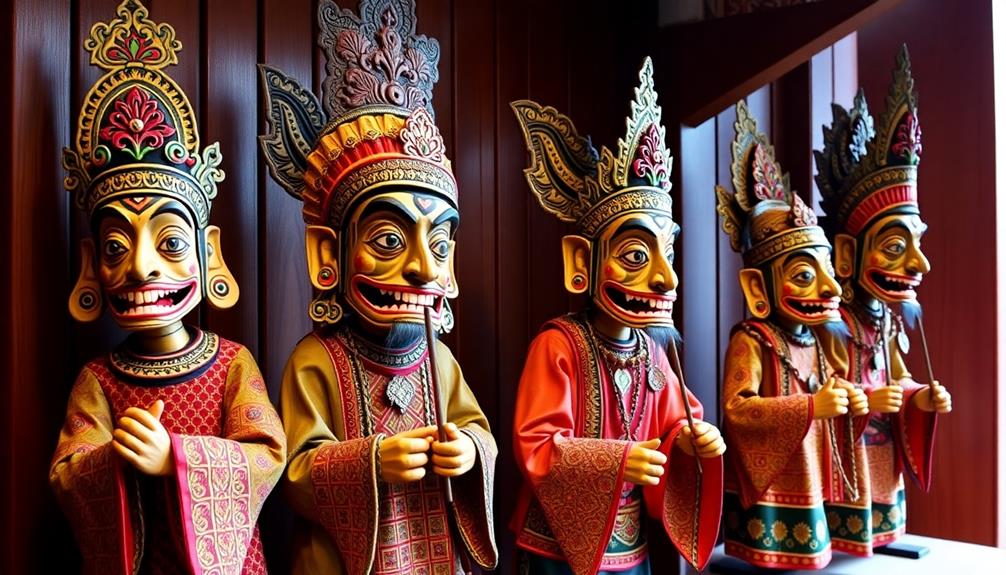
Javanese Wayang puppets aren't just beautiful; they carry deep cultural significance that dates back centuries.
These traditional figures often showcase intricate designs and vibrant colors, making them ideal for enhancing your home decor. You can use these intricately designed figures as striking decorative pieces in your home, whether as wall art or unique sculptures.
Their vibrant colors and storytelling elements can truly transform your living space while connecting you to Indonesia's rich heritage. Incorporating them into your decor can reflect the essence of Indonesian Wedding Decor and the artistry of local craftsmanship.
Cultural Significance of Wayang
Wayang puppets, with a history dating back to the tenth century, play an essential role in Javanese culture.
These traditional handcrafted figures are more than just art; they embody stories and values that have shaped Indonesian identity. Reflecting the rich diversity of Indonesian housing, Wayang puppets often showcase intricate designs that resonate with the regional architectural styles found in traditional homes like Rumah Adat.
When you explore the cultural significance of Wayang, you'll discover several key elements:
- Mythological Representation: Each puppet represents characters and tales that have been passed down through generations, preserving history and tradition.
- Spiritual Blessings: Wayang performances are believed to bring love, harmony, and spiritual blessings to homes, making them integral to community gatherings.
- UNESCO Recognition: Acknowledged as part of the Intangible Cultural Heritage of Humanity, Wayang puppetry highlights its importance in safeguarding Indonesian culture.
- Global Influence: These puppets have gained international acclaim, symbolizing Indonesian craftsmanship and storytelling, allowing you to connect with a rich heritage.
Decorative Uses in Homes
Decorating your home with Javanese Wayang puppets adds a unique touch that celebrates Indonesia's rich cultural heritage. Originating in Java during the tenth century, these traditional handmade crafts are closely tied to the ancient art of shadow puppetry.
You can showcase these exquisite puppets as decorative wall art, sculptures, or figurines, enhancing the cultural and artistic value of your living space. Incorporating intricate wooden carvings and vibrant colors typical of Indonesian art can further complement the Wayang puppets, creating a cohesive and lively decor theme that reflects the beauty of Indonesian wedding decor ideas.
Each puppet is intricately designed, reflecting the skilled craftsmanship and detailed artistry that make them stand out. Displaying Wayang puppets not only elevates your décor but also serves as a conversation starter, drawing guests into the fascinating narratives and folklore of Indonesia.
Plus, they're believed to bring love and harmony to households, adding a layer of charm to your environment.
Embracing Earthy Tones
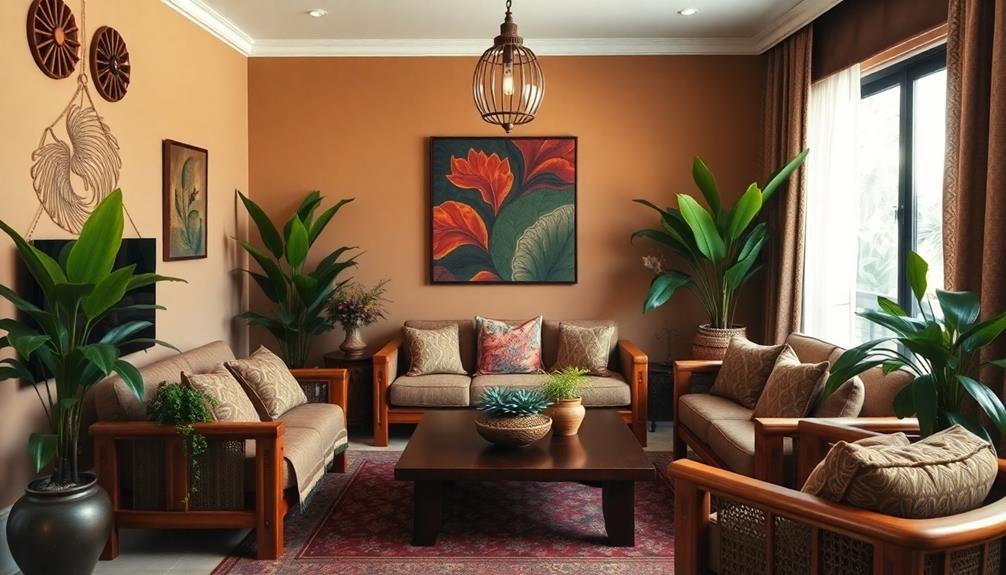
Embracing earthy tones can transform your space into a serene retreat, reflecting Indonesia's rich natural landscapes.
These shades of brown, green, and white promote a soothing atmosphere that resonates with the environment. Using earthy tones creates a sense of warmth and comfort, making your home feel inviting.
To effectively incorporate earthy tones into your decor, consider these four tips:
- Paint with Purpose: Choose soft browns or muted greens for walls to create a calming backdrop.
- Select Natural Materials: Opt for wooden furniture or stone accents that enhance the organic feel of your space.
- Balance with Neutrals: Pair earthy shades with whites or light grays to maintain an airy, spacious vibe.
- Add Greenery: Integrate indoor plants to complement the earthy palette, bringing life and freshness into your home.
Enhancing Spaces With Textiles

Incorporating textiles into your decor not only adds layers of texture but also infuses your space with the vibrant essence of Indonesian culture. Traditional Indonesian textiles, like batik and ikat, bring bold colors and intricate patterns that enhance visual interest and reflect cultural identity.
You can use batik fabric creatively in DIY projects such as wall art, cushion covers, and table settings. This approach provides a unique way to express your personal style while celebrating Indonesian craftsmanship.
Similarly, ikat fabric, known for its distinctive motifs and traditional dyeing methods, can elevate the aesthetic of various items in your home, including furniture upholstery and decorative accessories.
These textiles aren't just visually appealing; they're also durable, making them perfect for everyday use. Items like table runners, placemats, and cushion covers can withstand daily wear while adding a touch of elegance to your spaces.
To create a harmonious atmosphere, consider layering different textiles, like combining batik prints with natural materials such as rattan and wood. This combination reflects Indonesia's rich cultural heritage and creates a balanced environment in your home.
Sustainable Design Practices
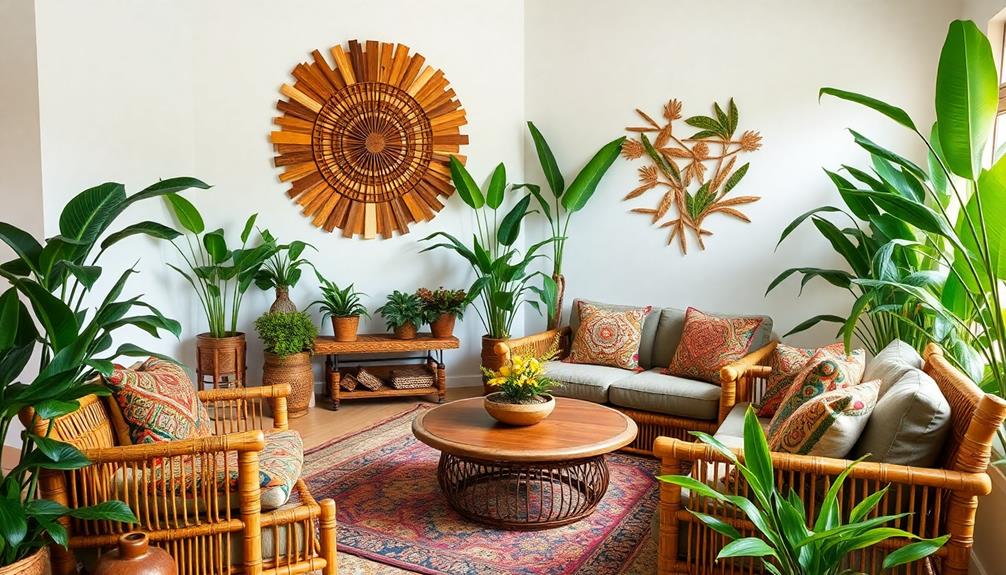
Sustainability is at the heart of contemporary Indonesian art decor, elevating both aesthetics and environmental responsibility.
By embracing sustainable design practices, you can create a home that reflects your values while supporting local artisans and the planet.
Here are some key elements to take into account:
- Natural Materials: Incorporate rattan, bamboo, and antique wood into your decor. These materials not only look beautiful but also promote eco-friendly sourcing.
- Upcycled Creations: Look for unique home decor items made from upcycled materials. This approach reduces waste and gives new life to discarded items, making your space truly one-of-a-kind.
- Eco-Friendly Textiles: Choose traditional textiles like batik and ikat that use natural dyes from plants and minerals. This supports sustainable practices in the textile industry.
- Support Local Artisans: By emphasizing local craftsmanship, you help nurture community economies while preserving traditional techniques and cultural heritage.
Integrating these sustainable design principles in your home decor not only minimizes environmental impact but also fosters a more conscious lifestyle.
Frequently Asked Questions
What Are the Characteristics of Indonesian Art?
Indonesian art features intricate craftsmanship, vibrant colors, and traditional textiles. You'll notice mythological themes, natural materials, and a focus on harmony, reflecting the rich cultural heritage and deep connection between humans, nature, and the divine.
Conclusion
Incorporating Indonesian art decor into your home is like adding a splash of color to a black-and-white photo. Each piece, from vibrant batik to intricate wood carvings, tells a story that enriches your living space. Embrace the earthy tones and textures to create a warm, inviting atmosphere that reflects your personality. By choosing sustainable designs, you're not just beautifying your home, but also honoring the rich culture behind these stunning artworks. Let your creativity shine! Incorporating vibrant Indonesian home decor colors into your living space can bring a sense of energy and vibrancy. Whether it’s a pop of bright blue or a burst of fiery red, these colors can liven up any room and create a sense of warmth and coziness. By infusing your home with these vibrant Indonesian home decor colors, you are not only adding visual interest but also showcasing your appreciation for the beauty of Indonesian art and culture.

